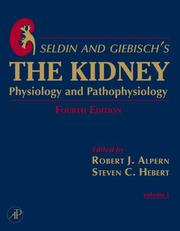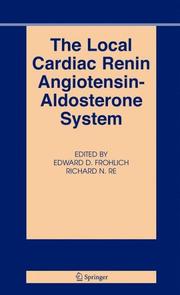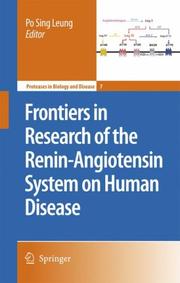| Listing 1 - 10 of 26 | << page >> |
Sort by
|

ISBN: 9780120884889 0120884887 9780120884896 9780120884902 9786611762315 1281762318 0080559506 9780080559506 Year: 2008 Publisher: Amsterdam Boston Elsevier Academic Press
Abstract | Keywords | Export | Availability | Bookmark
 Loading...
Loading...Choose an application
- Reference Manager
- EndNote
- RefWorks (Direct export to RefWorks)
A classic nephrology reference for over 20 years, Seldin & Giebisch's The Kidney, is the acknowledged authority on renal physiology and pathophysiology. The fourth edition follows the changed focus of nephrology research to the study of how individual molecules work together to affect cellular and organ function, emphasizing the mechanisms of disease. With over 40 new chapters and over 1000 illustrations, this edition offers the most in-depth discussion anywhere of the physiologic and pathophysiologic processes of renal disease. Comprehensive, authoritative coverage progresses fr
Nieren. --- Fysiologie. --- Pathologische fysiologie. --- Kidney --- Kidney Diseases --- Water-Electrolyte Balance. --- Water-Electrolyte Imbalance. --- Kidneys --- Water-electrolyte imbalances --- Water-electrolyte balance (Physiology) --- Reins --- Troubles hydroélectrolytiques --- Equilibre hydroélectrolytique (Physiologie) --- physiology. --- physiopathology. --- Physiology. --- Diseases. --- Physiologie --- Maladies --- Electrolyte Balance --- Fluid Balance --- Balance, Electrolyte --- Balance, Fluid --- Balance, Water-Electrolyte --- Water Electrolyte Balance --- Electrolytes --- Osmotic Pressure --- Water-Electrolyte Imbalance --- Imbalance, Water-Electrolyte --- Imbalances, Water-Electrolyte --- Water Electrolyte Imbalance --- Water-Electrolyte Imbalances --- Water Intoxication --- Water-Electrolyte Balance --- Pathophysiology. --- Kidney diseases --- Nephritis --- Nephropathy --- Renal diseases --- physiology --- physiopathology
Book
ISBN: 0123814626 1283891565 0123814634 9780123814623 9780123972071 0123972078 9780123972088 0123972086 9780123814630 Year: 2013 Publisher: Burlington
Abstract | Keywords | Export | Availability | Bookmark
 Loading...
Loading...Choose an application
- Reference Manager
- EndNote
- RefWorks (Direct export to RefWorks)
A classic nephrology reference for over 25years, Seldin and Giebisch's The Kidney, is the acknowledged authority on renal physiology and pathophysiology. In this 5th edition, such new and powerful disciplines as genetics and cell biology have been deployed to deepen and widen further the explanatory framework. Not only have previous chapters been extensively updated, but new chapters have been added to incorporate additional disciplines. Individual chapters, for example, now provide detailed treatment of the significance of cilia; the role of stem cells is now given special consideration. Finally, there has been a significant expansion of the section of pathophysiology, incorporating the newer findings of cell biology and genetics. If you research the development of normal renal function or the mechanisms underlying renal disease, Seldin and Giebisch's The Kidney is your number one source for information. Offers the most comprehensive coverage on the market of fluid and electrolyte regulation and dysregulation in 85 completely revised chapters and 10 new chapters Includes 4sections, 62 chapters, devoted to regulation and disorders of acid-base homeostasis, and epithelial and nonepithelial transport regulation Includes foreword by Donald Seldin and Gerhard Giebisch, world renowned names in nephrology and editors of the previous three editions.
Nephritis --- Nephropathy --- Renal diseases --- Kidneys --- Physiology. --- Pathophysiology. --- Diseases. --- Kidney diseases --- Kidney --- Kidney Diseases --- Water-Electrolyte Balance --- Water-Electrolyte Imbalance --- 612.46 --- 612.46 Kidneys. Renal functions. Urine --- Kidneys. Renal functions. Urine --- Imbalance, Water-Electrolyte --- Imbalances, Water-Electrolyte --- Water Electrolyte Imbalance --- Water-Electrolyte Imbalances --- Electrolytes --- Osmotic Pressure --- Water Intoxication --- Electrolyte Balance --- Fluid Balance --- Balance, Electrolyte --- Balance, Fluid --- Balance, Water-Electrolyte --- Water Electrolyte Balance --- physiology --- physiopathology
Book
ISBN: 0128013648 0128014857 9780128013649 9780128014851 Year: 2015 Publisher: Amsterdam, [Netherlands] : Academic Press,
Abstract | Keywords | Export | Availability | Bookmark
 Loading...
Loading...Choose an application
- Reference Manager
- EndNote
- RefWorks (Direct export to RefWorks)
Renin-angiotensin system. --- RA system --- RAA system --- RAAS (Physiology) --- RAS (Physiology) --- Renin-angiotensin-aldosterone axis --- Renin-angiotensin-aldosterone system --- Aldosterone --- Angiotensins --- Renin --- Water-electrolyte balance (Physiology) --- Blood pressure --- Regulation
Book
ISBN: 9535133527 9535133519 953514748X Year: 2017 Publisher: IntechOpen
Abstract | Keywords | Export | Availability | Bookmark
 Loading...
Loading...Choose an application
- Reference Manager
- EndNote
- RefWorks (Direct export to RefWorks)
Exploring the contractile activity of smooth muscle segments isolated from various organs of healthy animals and animals with experimentally induced diabetes, she obtained original data about angiotensin II-induced force and time parameters. For the first time, she established the effect of ghrelin on angiotensin II-provoked contraction of the urinary bladder. Original data on the role of both types of angiotensin receptors for the contractile activity of the various segments of the gastrointestinal tract and bladder were obtained. By applying specific software for force and time parameter analysis, the contribution of different types of angiotensin receptors on muscle contractility has been shown. The new methodology was used to analyze the data obtained during the registration of smooth muscle relaxation activity, which allows the determination of not only the magnitude of the mechanical response but also the parameters related to the time and speed of the contractions. Plasma renin activity models have been developed using mathematical approaches to predict the effect of different drug doses on the behavior of the system.
Renin-angiotensin system. --- RA system --- RAA system --- RAAS (Physiology) --- RAS (Physiology) --- Renin-angiotensin-aldosterone axis --- Renin-angiotensin-aldosterone system --- Aldosterone --- Angiotensins --- Renin --- Water-electrolyte balance (Physiology) --- Blood pressure --- Regulation --- Medicine --- Neuroendocrinology --- Cardiology and Cardiovascular Medicine --- Health Sciences
Book
ISBN: 3030483746 3030483738 Year: 2020 Publisher: Cham, Switzerland : Springer,
Abstract | Keywords | Export | Availability | Bookmark
 Loading...
Loading...Choose an application
- Reference Manager
- EndNote
- RefWorks (Direct export to RefWorks)
This revised and expanded second edition presents the most recent evidence-based facts on perioperative fluid management and discusses fluid management from basic sciences to clinical applications and the patients’ outcomes. Recent advances in understanding the Revised Starling principle with new concepts in tissue perfusion and the most recent techniques of perioperative goal directed fluid management are described. The endothelial glycocalyx functions and the influence of fluid management on its integrity are covered in detail; moreover, the techniques for its protection are also discussed. The dilemma of perioperative use of hydroxyethyl starch solutions and the resurgence of interest in using human albumin as an alternative colloid is explored. The problems of using unbuffered solutions during the perioperative period and comparison between restrictive versus liberal fluid management are discussed in full. Lastly, case scenarios for every possible clinical situation describe in full the most up-to-date fluid management for the corresponding clinical problem. Perioperative Fluid Management, Second Edition is of interest to anesthesiologists and also intensivists.
Anesthesiology. --- Critical care medicine. --- Intensive / Critical Care Medicine. --- Intensive care --- Intensive medicine --- Medicine --- Emergency medicine --- Intensive care units --- Anaesthesiology --- Surgery --- Fluid therapy. --- Fluid replacement therapy --- Fluids --- Therapeutics --- Water-electrolyte balance (Physiology) --- Therapeutic use
Book
ISBN: 1681083132 9781681083131 Year: 2016 Publisher: Sharjah Bentham Science Publishers
Abstract | Keywords | Export | Availability | Bookmark
 Loading...
Loading...Choose an application
- Reference Manager
- EndNote
- RefWorks (Direct export to RefWorks)
Renin-angiotensin system. --- Renin-angiotensin system --- Kidneys --- Kidney diseases --- Nephritis --- Nephropathy --- Renal diseases --- RA system --- RAA system --- RAAS (Physiology) --- RAS (Physiology) --- Renin-angiotensin-aldosterone axis --- Renin-angiotensin-aldosterone system --- Aldosterone --- Angiotensins --- Renin --- Water-electrolyte balance (Physiology) --- Blood pressure --- Diseases. --- Regulation

ISBN: 1280460458 9786610460458 0387278265 0387278257 Year: 2006 Volume: 20 Publisher: New York : Springer,
Abstract | Keywords | Export | Availability | Bookmark
 Loading...
Loading...Choose an application
- Reference Manager
- EndNote
- RefWorks (Direct export to RefWorks)
How exciting it is to see a field so well established as the ren- angiotensin system continue to grow and mature. Originally, following the original identification of renin by Tigerstedt and Bergman over 100 years ago, workers in this area spent years attempting to establish its role in experimental and renal hypertension. The early work by Goldblatt, in 1934, demonstrated that the placement of a clip around a renal artery was clearly related to the subsequent development of hypertension. However, it wasn't until the simultaneous finding by two different geographically separated teams, Page, et al, in the United States and Braun-Menendez, et al, in Argentina that the peptide angiotensin was identified. Thus, the rate-limiting enzyme renin was released from the kidney and catalyzed a biochemical cascade which was eventually shown to produce the elevated arterial pressure. Subsequently, many workers contributed to the elucidation of the concept and sequence of angiotensin I1 generation. Thus, the enzyme renin acted upon its protein substrate, produced in the liver, to liberate the decapeptide angiotensin I which, upon circulating through the pulmonary circulation, finally produced the potent octapeptide angiotensin. Several important subsequent findings demonstrated that angiotensin I1 promoted the release of the adrenal corticosteroid from that gland, thereby resulting in a larger system, the renin-angiotensin-aldosterone system. Further, this system demonstrated a classical biofeedback and the circulating octapeptide was shown to have additional biological activities in organs other than heart, vessels, kidney, adrenals, and even brain.
Renin-angiotensin system. --- Heart --- Renal hypertension. --- Renin. --- Physiology. --- Aspartic proteinases --- Juxtaglomerular apparatus --- Renal parenchymatous hypertension --- Hypertension --- Kidneys --- RA system --- RAA system --- RAAS (Physiology) --- RAS (Physiology) --- Renin-angiotensin-aldosterone axis --- Renin-angiotensin-aldosterone system --- Aldosterone --- Angiotensins --- Renin --- Water-electrolyte balance (Physiology) --- Blood pressure --- Diseases --- Regulation --- Cardiology. --- Internal medicine

ISBN: 1281116793 9786611116798 1402063725 1402063717 Year: 2007 Volume: v. 7 Publisher: Dordrecht, Netherlands : Springer,
Abstract | Keywords | Export | Availability | Bookmark
 Loading...
Loading...Choose an application
- Reference Manager
- EndNote
- RefWorks (Direct export to RefWorks)
The significant impact of the renin-angiotensin system (RAS) on basic research and its clinical relevance are reflected by the flourishing publication of original and review research articles; by the appearance of whole issues of journals dedicated to the RAS; and by specialist books on the RAS. In such a rapidly evolving environment, publications that span the spectrum from basic research to the bedside, fill a particularly valuable niche for clinicians and researchers alike. The primary aim of this book is to provide a topical and timely forum for the critical appraisal of an area of RAS res
Diseases. --- Renin-angiotensin system. --- RA system --- RAA system --- RAAS (Physiology) --- RAS (Physiology) --- Renin-angiotensin-aldosterone axis --- Renin-angiotensin-aldosterone system --- Aldosterone --- Angiotensins --- Renin --- Water-electrolyte balance (Physiology) --- Blood pressure --- Human beings --- Illness --- Illnesses --- Morbidity --- Sickness --- Sicknesses --- Medicine --- Epidemiology --- Health --- Pathology --- Sick --- Regulation --- Diseases
Book
ISBN: 0429183275 1482223317 1000218961 1482223287 9781482223286 Year: 2019 Publisher: Boca Raton, FL : CRC Press,
Abstract | Keywords | Export | Availability | Bookmark
 Loading...
Loading...Choose an application
- Reference Manager
- EndNote
- RefWorks (Direct export to RefWorks)
Body fluids. --- Hydration. --- Dehydration (Physiology) --- Body water loss --- Water-electrolyte imbalances --- Animal fluids and humors --- Body humors --- Fluids, Body --- Fluids and humors, Animal --- Humors, Body --- Water-Electrolyte Imbalance. --- Athletic Performance. --- Water-Electrolyte Balance --- Athletic ability --- Troubles hydroélectrolytiques --- Sports, Aptitude pour les --- physiology.
Periodical
Abstract | Keywords | Export | Availability | Bookmark
 Loading...
Loading...Choose an application
- Reference Manager
- EndNote
- RefWorks (Direct export to RefWorks)
Renin-angiotensin system --- Renin-Angiotensin System --- Periodicals. --- Système rénine-angiotensine --- Renin-angiotensin system. --- Chemistry --- Health Sciences --- Life Sciences --- Social Sciences --- Biochemistry --- General and Others --- Physiology --- Behavioral Science (Psychology) and Counselling --- renin-angiotensin-aldosterone system --- biomedicine --- Système rénine-angiotensine --- RA system --- RAA system --- RAAS (Physiology) --- RAS (Physiology) --- Renin-angiotensin-aldosterone axis --- Renin-angiotensin-aldosterone system --- Aldosterone --- Angiotensins --- Renin --- Water-electrolyte balance (Physiology) --- Blood pressure --- Regulation --- Human medicine
| Listing 1 - 10 of 26 | << page >> |
Sort by
|

 Search
Search Feedback
Feedback About UniCat
About UniCat  Help
Help News
News